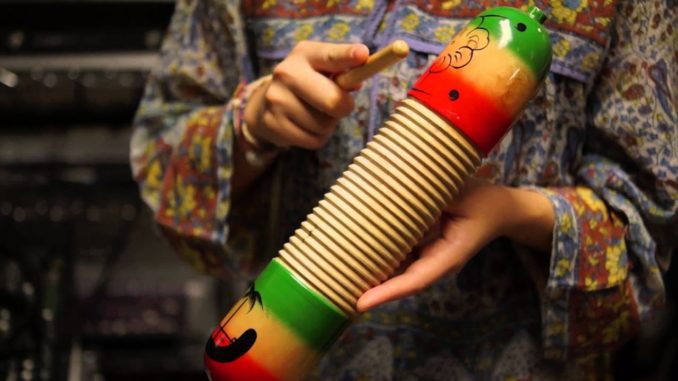
The güiro (also known as the guiro) is a percussion instrument that has been used in traditional music across the Americas for centuries. It is a hollow gourd with ridges carved into its surface, which are scraped with a stick or other utensil to create a raspy, rhythmic sound. In this article, we will explore the history, how to play, sound, and cultural significance of the güiro. The Guiro is an example of a scraped idiophone, which is an instrument that produces sound by scraping with a stick or other non-vibrating object.

What is a Güiro
History of the Güiro
The güiro is believed to have originated in pre-Columbian America, with early examples dating back to the Maya and Aztec civilizations. These early güiros were made from natural materials such as clay, wood, and animal horns, and were used in a variety of ceremonies and rituals.
With the arrival of the Spanish colonizers in the 16th century, the güiro was introduced to new materials such as metal and glass, and its use spread throughout Latin America and the Caribbean. Today, the güiro is an essential instrument in many genres of Latin music, including salsa, merengue, cumbia, and son.
It is similar to the African instrument, the reco reco.
How to Play the Güiro
To play the güiro, you will need a güiro and a stick or other utensil. Hold the güiro in one hand, and hold the stick in the other hand, with the stick resting on top of the ridges on the güiro’s surface. Use a scraping motion to move the stick back and forth along the ridges, creating a raspy, rhythmic sound.
The sound of the güiro can be varied by changing the angle and pressure of the stick as it scrapes along the ridges. Different parts of the güiro’s surface may also produce different sounds, allowing for a wide range of rhythmic possibilities.
How does the Güiro Sound?
The güiro’s sound is distinctive and instantly recognizable. Its raspy, percussive quality adds a lively, rhythmic element to music, and it is often used to create intricate rhythms and syncopations. The sound of the güiro can be used to create a variety of moods, from festive and celebratory to mournful and introspective.
Its presence in various genres of dance music and latin american music, such as salsa and merengue, contributes to the vibrant and infectious rhythms that get people moving on the dance floor.
Cultural Significance of the Güiro
The güiro has a deep cultural significance in many Latin American and Caribbean countries. It is often associated with traditional music and dance, and is an important symbol of cultural identity and heritage.
In many communities, the güiro is also used in religious and spiritual ceremonies. For example, in Puerto Rico, the güiro is used in the traditional Christmas carol “Aguinaldo” as a symbol of the shepherd’s crook, a reference to the biblical story of the Nativity.
The güiro has also played a role in the social and political history of Latin America. During the Cuban Revolution, the güiro was used as a symbol of resistance against the Batista regime, and it continues to be associated with revolutionary movements in the region.
In addition to its cultural and symbolic significance, the güiro is also a versatile instrument that can be played in a variety of contexts. It is often used in traditional folk music, but it has also been incorporated into modern genres such as jazz, rock, and hip-hop.
What is the difference between a Güiro and an Güira?
The terms güiro and güira are often used interchangeably, but technically they refer to two different instruments.
The güiro is a percussion instrument made from a hollow gourd or other material with ridges carved into its surface. It is played by scraping a stick or other utensil along the ridges, creating a raspy, rhythmic sound. The güiro is commonly found in traditional Latin American and Caribbean music, and has a deep cultural significance in these regions.
The güira, on the other hand, is a metal instrument made from a hollowed-out metal cylinder with raised ridges on its surface. It is played in a similar way to the güiro, with a metal scraper or “tines” used to create a rasping sound. The güira is commonly found in merengue music, a style of music from the Dominican Republic.
While the güiro and güira share some similarities in terms of their sound and how they are played, they are distinct instruments with different origins, materials, and cultural contexts.
Conclusion
The güiro is a unique and versatile instrument that has played a significant role in the cultural history of the Americas. From its pre-Columbian origins to its modern-day use in a variety of musical genres, the güiro’s distinctive sound and cultural significance make it an important symbol of Latin American and Caribbean identity and heritage. Whether played in a traditional folk ensemble or a modern jazz band, the güiro’s raspy, percussive sound adds a lively and rhythmic element to music, and its rhythmic possibilities continue to be explored by musicians and composers around the world.
What is a Cimbalom?
What is a Stylophone?
What is an Otomatone?
What is a Cuica?
What is a Tam-Tam?
